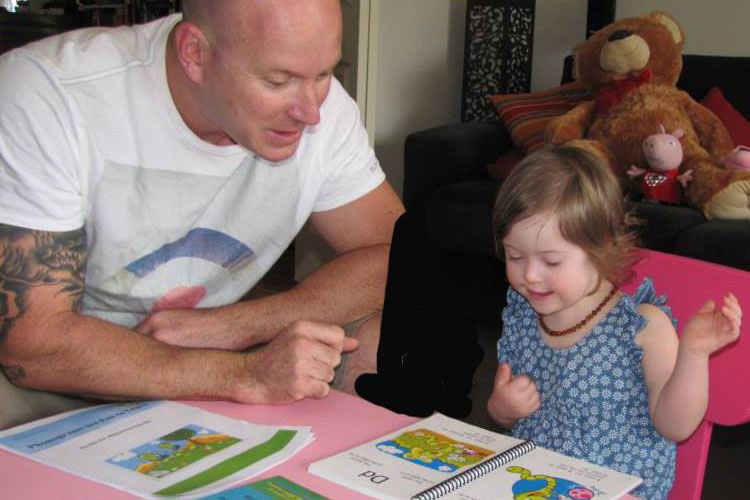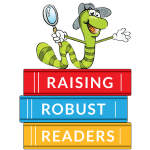Are you looking for a reading program that has been proven to help children and adults with Down syndrome? Then Read on.
Raising Robust Readers is a phonics-based, phonogram-specific, family-friendly reading program that uses multi-sensory teaching strategies to go beyond the 26 alphabet letters to teach the remaining 46 letter combinations that make independent reading logical, predictable and easy to decode.
We teach parents using the same songs, gestures and animated videos that they can use as they engage with their children. With the Raising Robust Readers program, children are not taught tethered to a desk or worksheet. Teaching takes place where the reading needs to happen: on the go, wherever they go. The world becomes the workbook. Environmental print (menus, signs, groceries), toys and play become the worksheet. It’s meaningful. It’s relevant. It’s fun. And it helps struggling readers learn through multi-sensory play.
Learn more about why children with Down syndrome struggle with conventional reading programs.
We invite you to scroll down to read more and find out how it can help you and your family!
The Raising Robust Readers Course:
Why choose our course?

Phonics Works!! - When Taught the Right Way
Not all phonics programs are created equal. Decoding (sounding out) words in the traditional, letter-by-letter manner can have crippling results. Try sounding out ‘eight’ one letter at a time. Now try explaining how that result equals ‘eight.’ The default solution is to make it a sight word. But there is a better way. Using the same example, when beginning readers read words by sounds (‘eigh' says long /a/), they experience success. /a/ + /t/ = eight. No sight words necessary! With phonograms, the confusion, frustration and failure can be remedied.

Child-Centered and Family-Focused
Raising Robust Readers is child-centered, not curriculum-driven. Your child's individuality is honored through flexible planned sessions and, even more important, impromptu teachable moments. You can focus on the strengths and needs of your child, not the table of contents nor the timeline of a workbook. Jingles, gestures and clue box items make learning play-filled. Interest is higher. Retention is stronger. Parents, our most influential teachers, are guided and supported with step-by-step instructional modules, hard copy books, engaging videos and downloadable materials.

Research-Based + Real Life Know-How
Raising Robust Readers incorporates the best practices reported by highly recognized national reading organizations such as the National Reading Panel, the National Right to Read Foundation and the National Center for Learning Disabilities. Thus, multi-sensory, explicit and systematic instruction of phonics is at the core of our program. But, even more important, are the "real- life" best practices. The ones that can only come from experience. From trial and error. From learning what works best. From parenting and teaching and living Down syndrome.

On The Go Wherever You Go
When parents teach, and children learn, on the go wherever you go, the experience is easier, more enjoyable and more meaningful. The car, restaurants, supermarkets, the kitchen pantry and the doctor’s office replace stressful study sessions at desks and tables. The world is your workbook, and environmental print is your worksheet. Generalizing is no longer a big problem because learning takes place in meaningful real-life locations. (Hint: phonogram hunts in the cereal aisle are not only educational. They keep the kids busy! )

All Ages and All Stages
Raising Robust Readers is personality-perfect for those with Down syndrome. It is designed to be simple, clear, and consistent to complement our learners’ strong propensity toward routine, structure, predictability and trust. But instruction can be easily adjusted and adapted for all ages and ability levels. Thus, when using developmentally appropriate strategies, everyone may benefit — from babies to adults, and from strong readers to struggling readers.

What Sets Us Apart
Our sequence of instruction is a carefully crafted departure from traditional approaches. Blending begins very early so learners experience the joy of reading, not just saying sounds and recognizing letters. Each phase is designed in small successful steps from simple to complex; from sounds to syllables... and beyond to practical applications in real life. Our video instruction of the six syllable types and their effect on the sounds of vowels, along with guidelines for syllable division, take the guesswork and insecurity out of decoding longer words.
Robust Readers in Real Life:
Meet Devin and Casey, two young men with Down syndrome whose lives have been changed by the Raising Robust Readers program.
Devin is 26 years old and graduated from high school unable to read. When he and his mom began working with Raising Robust Readers, Devin could not correctly identify the names nor sounds of all the letters. Click on our short video to see a snippet of his progress after eight sessions.



"He's learned more in 3 months than he has in 18 years of school."
Angie
Mother of an adult son with Down syndrome, who is learning to read with Raising Robust Readers



"Mom, I just love this. It makes me feel alive."
Devin
Explaining about how learning to read makes him feel
From Judy O'Halloran
Co-Founder of Raising Robust Readers and Casey's mom
Casey O’Halloran is the genesis of our reading program. In high school, he was still on a track to graduate functionally illiterate. As 1) his mother and 2) a teacher with a degree in English Education, this was not acceptable to me. Without going into the details of the eight years of active research and myriad attempted reading programs, I will just say that, at 17, we discovered ‘phonograms,’ and Casey made the quantum leap to being able to read and write independently, to understand and to express himself in print.
This ability has facilitated his living in his own condo, taking public transportation to work at the courthouse (where reading is essential to his position as a clerical assistant), and choosing his own recreational activities. It certainly helped him fulfill his responsibilities when he was appointed twice by President Bush to the President’s Committee for People with Intellectual Disabilities.
While this is quite an honor, there is another accomplishment that I hold even higher. Casey is the acknowledged ‘card guy’ in our family. Everyone eagerly opens his or her card, knowing that he has spent much time poring over many until he finds just the right one to express his feelings on that occasion. Every time I open a Mother’s Day or birthday card; read the perfect verses; and savor Casey’s notes at the bottom, I am reminded that our journey toward independent literacy was worth every minute.


The Benefits of Independent
Reading for Individuals with
Down Syndrome
LEAP BEYOND THE LIMITS OF SIGHT WORDS
When our children first begin to recite whole words--such as Mommy, Daddy, Rover, blue--we can hardly contain our excitement. This is proof that our children will read! But, over time, we accept the fact that the books our children read, at school and for pleasure, contain more than their memorized repertoire. We realize they must be able to do more than memorize in order to keep progressing. Having the skills to 'attack' and conquer unfamiliar words will take them down the crucial path of literacy. Phonics, and more specifically phonograms, will give them that ability.
INCREASES ACADEMIC PROGRESS AND SUCCESS
Being able to read affects all the areas of academics. "We learn to read. Then we read to learn." This statement holds true for all areas of academics beyond 'reading class': science, social studies, language arts. Even math has word problems! If our students cannot read independently, think about the expanded impact on classroom discussions that follow assignments, homework, outside research or non-fiction books. When our students have some level of independent reading, all the components of literacy are strengthened and grow: comprehension, vocabulary, fluency, writing, spelling, and critical thinking.
EXPANDS OPPORTUNITIES AND OPTIONS IN ADULTHOOD
When our children are younger, our reading concerns tend to focus on school. But the real impact will occur in adulthood. Just because our young and older adult children do not read independently, does not mean they can't work or live away from home. But their options and opportunities are certainly thwarted. Being a functionally literate adult broadens options and opportunities for independent housing, transportation, competitive employment, and a richer social/emotional life. And the time to prepare for adulthood is childhood: read a menu, follow clothes washing directions, look up movie titles and times on the internet, and on and on and on. As Dr. Seuss would say, "You're off to Great Places! Today is your day! Your mountain is waiting. So...get on your way!"
CREATES THE WOW FACTOR
"WOW!! She can read???" Did you hear the accompanying sound? That's the wall of false beliefs crumbling. All of a sudden the observer has a totally different opinion of your child, and what she can do. Now, he wants to learn more about her--and about Down syndrome. The more he learns, the more he discards society's false perceptions, and changes his thinking--as well as his actions. All of a sudden, the perception of your child-be she young or adult-has just been elevated to WOW! And every time this happens:Opinions change. Opportunities knock. Doors open.
Down Syndrome Reading Strategies
The Raising Robust Readers Course:
Ideal for Busy Parents & Struggling Readers
The Online Course with 18 step-by-step modules includes everything you need to teach your child how to read, including downloadable worksheets, fun-filled activities and more!
Easy for parents to learn and teach. Our online course videos guide you through the course, and show you the most effective methods to teach your child.
Uses the multi-sensory, research-based Orton-Gillingham approach
Awards and Accolades

Authors Judy O’Halloran and Marilee Senior received a 2015 Moonbeam Children’s Book Award for literacy for “The ABCs of the Sounds We Read: Going Beyond the Alphabet to Discover the Reading Code.”

Raising Robust Readers has been chosen by GiGi's Playhouse Down Syndrome Achievement Centers to be used internationally with their literacy programs. Click here to watch an overview of GiGi's Playhouse/Raising Robust Readers phonics program. See it in action!
Course FAQs


